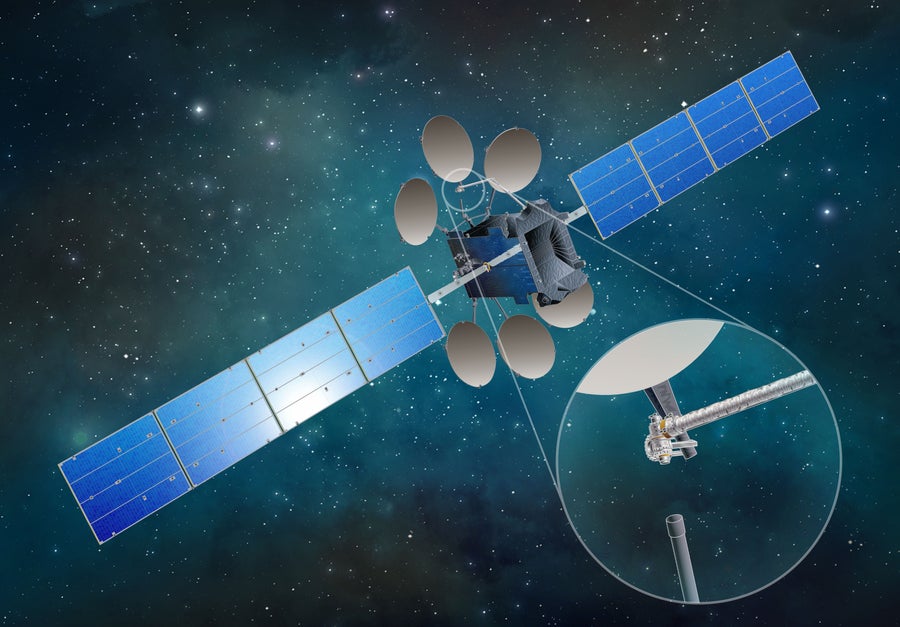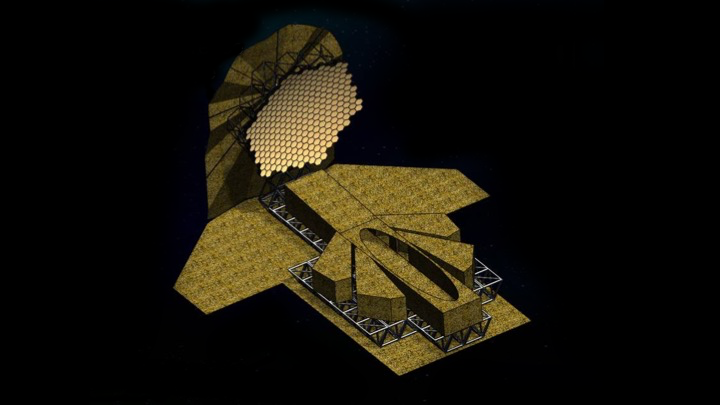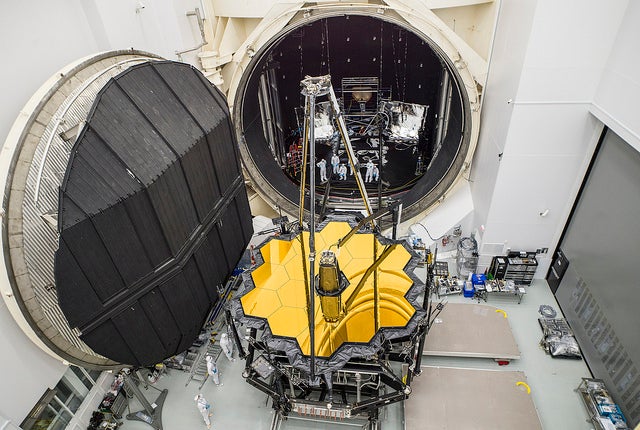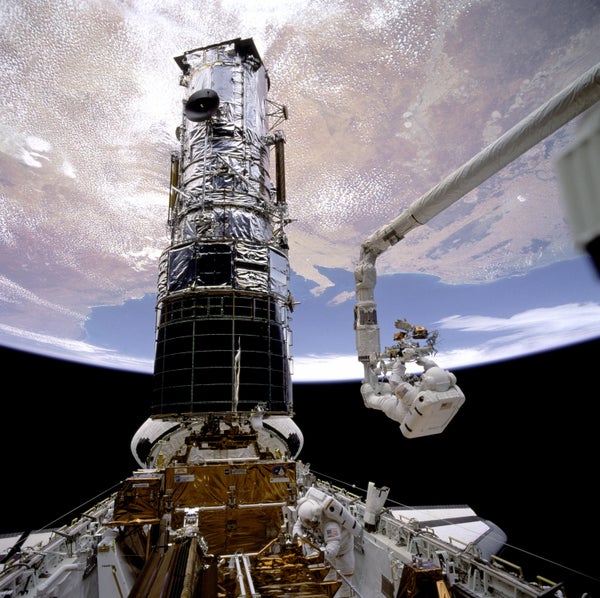After snapping the final piece into place with a satisfying “click” she feels through her spacesuit gloves, the astronaut pauses to appreciate the view. Her reflection swims before her in a silvery disk the size of three tennis courts; for a moment she feels like a bug floating on a darkened pond. Composed of hundreds of interlocking metallic hexagons like the one she has just installed, the disk is a colossal mirror 30 meters wide, the starlight-gathering eye of the largest space telescope ever built. From her perch on the robotic arm of a small space station, Earth is a tiny blue and white orb she could cover with an outstretched thumb, dwarfed by the bright and silent moon spinning thousands of kilometers below her feet.
Although this scene remains the stuff of science fiction, an ad hoc assemblage of scientists, engineers and technocrats now say it is well on its way to becoming reality. Under the auspices of a modest NASA-sponsored initiative, this diverse group is gauging how the space agency might build bigger, better space telescopes than previously thought possible—by constructing and servicing them in space. The effort, formally known as the “in-Space Assembled Telescope” study (iSAT), is part of a long trend in which science advances by piggybacking on technologies created for more practical concerns.
For example, the development of surveillance satellites and warhead-carrying rockets during the 20th-century cold war also catalyzed the creation of robotic interplanetary probes and even NASA’s crewed Apollo lunar missions. Similarly, in the 21st century a soaring military and industrial demand for building and servicing satellites in orbit could lead to dramatically enhanced space telescopes capable of definitively answering some of science’s biggest questions—such as whether or not we are alone. “The iSAT is a program that can be NASA’s next Apollo,” says study member Matt Greenhouse, an astrophysicist at the space agency’s Goddard Space Flight Center. “And the science enabled by the iSAT would likely include discovery of extraterrestrial life—an achievement that would eclipse Apollo in terms of impact on humanity.”
On supporting science journalism
If you're enjoying this article, consider supporting our award-winning journalism by subscribing. By purchasing a subscription you are helping to ensure the future of impactful stories about the discoveries and ideas shaping our world today.
Ready for Prime Time
In some respects, building and repairing spacecraft in space is a revolution that has already arrived, merely kept under the radar by a near-flawless track record that makes it seem deceptively routine.Two of NASA’s pinnacle projects—the International Space Station (ISS) and the Hubble Space Telescope—owe their existence to orbital construction work. Assembled and resupplied in orbit over two decades, the ISS is now roughly as big as a football field and has more living space than a standard six-bedroom house. And only space-based repairs allowed Hubble to become the world’s most iconic and successful telescope, after a space shuttle crew on a first-of-its-kind servicing mission in 1993 fixed a crippling defect in the observatory’s primary mirror. Astronauts have since conducted four more Hubble servicing missions, replacing equipment and upgrading instruments to leave behind an observatory reborn.

An artist’s rendition of the upcoming Dragonfly mission, a collaboration between NASA and Space Systems Loral to demonstrate technologies required for orbital construction. Dragonfly’s robotic arm (inset) will assemble and deploy reflectors to create a large radio antenna when the mission launches sometime in the 2020s. Credit: NASA and SSL
Today multiple projects are carrying the momentum forward from those pioneering efforts, cultivating powerful new capabilities. Already NASA and the Pentagon’s Defense Advanced Research Projects Agency (DARPA) as well as private-sector companies such as Northrop Grumman and Space Systems Loral (SSL) are building robotic spacecraft for launch in the next few years on lengthy missions to refuel, repair, re-position and upgrade governmental and commercial satellites. Those spacecraft—or at least the technologies they demonstrate—could also be used to assemble telescopes and other large structures in space such as those associated with NASA’s perennial planning for human missions to the moon and Mars. Last year—under the auspices of a “partnership forum” between NASA, the U.S. Air Force and National Reconnaissance Office—the space agency took the lead on crafting a national strategy for further public and private development of in-space assembly in the 2020s and beyond.
These trends could end what some experts see as a “dark age” in space science and exploration. “Imagine a world where once your car runs low on fuel, instead of driving to the gas station you take it to the junkyard and abandon it. Imagine a world where once you’ve moved into your house for the first time you have no way of ever getting more groceries inside, having a plumber come to fix a leaky pipe or any way to bring in and install a new TV. Imagine a world where we all live in tents that we can carry on our backs and no one thinks to build anything larger or more permanent. That seems crazy, doesn’t it?” says iSAT study member Joe Parrish, a program manager for DARPA’s Tactical Technology Office who helms its Robotic Servicing of Geosynchronous Satellites (RSGS) mission. “But that’s exactly the world we live in right now with our $1-billion–class assets in space. … I think we will look back on the era before on-orbit servicing and assembly the way we now look back on the era when leeches were used to treat diseases.”
Bigger Is Better
The fundamental reality behind the push for in-space assembly is easy to understand: Anything going to space must fit within the rocket taking it there. Even the very biggest—the mammoth 10-meter rocket fairing of NASA’s still-in-development Space Launch System (SLS)—would be unable to hold something like the ISS or even the space agency’s smaller “Gateway,” a moon-orbiting space station proposed for the 2020s. Launching such megaprojects piece by piece, for orbital assembly by astronauts or robots, is literally the only way to get them off the ground. And coincidentally, even though massive “heavy lift” rockets such as the SLS remain ruinously expensive, the midsize rockets that could support orbital assembly with multiple launches are getting cheaper all the time.
The forces demanding supersize space telescopes are straightforward, too: The larger a scope’s light-collecting mirror is, the deeper and finer its cosmic gaze. Simply put, bigger is better when it comes to telescopes—especially ones with transformative objectives such as tracking the coalescence of galaxies, stars and planets throughout the universe’s 13.8-billion-year history, learning the nature of dark matter and dark energy, and seeking out signs of life on habitable worlds orbiting other stars. Most of today’s designs for space telescopes pursuing such alluring quarry cap out with mirrors as wide as 15 meters—but only because that is the approximate limit of what could be folded to fit within a heavy-lift rocket like the SLS.
Astronomers have long fantasized about building space observatories even bigger, with mirrors 30 meters wide or more—rivaling the sizes of ground-based telescopes already under construction for the 2020s. Assembled far above our planet’s starlight-scattering atmosphere, these behemoths could perform feats the likes of which ground-based observers can only dream, such as taking pictures of potentially Earth-like worlds around a huge sample of other stars to determine whether those worlds are actually habitable—or even inhabited. If our own Earth is any example to go by, life is a planetary phenomenon that can transform the atmosphere and surface of its home world in clearly recognizable ways; provided, that is, one has a telescope big enough to see such details across interstellar distances.
A recent “Exoplanet Science Strategy” report from the National Academies of Sciences, Engineering and Medicine said NASA should take the lead on a major new space telescope that begins to approach that grand vision—something capable of surveying hundreds (or at least dozens) of nearby stars for snapshots of potential exo-Earths. That recommendation (itself an echo from several previous prestigious studies) is reinforced by the core conclusion of another new Academies report which calls for the agency to make the search for alien life a more fundamental part of its future space exploration activities. These reports build on the growing consensus that our galaxy likely holds billions of potentially habitable worlds, courtesy of statistics from NASA’s recently deceased Kepler space telescope and the space agency’s newly launched Transiting Exoplanet Survey Satellite. Whether viewed through the lens of scientific progress, technological capability or public interest, the case for building a life-finding space telescope is stronger than ever before—and steadily strengthening. Sooner or later it seems NASA will find itself tasked with making this longed-for giant leap in the search for life among the stars.
How big such a telescope must be to offer a reasonable chance of success in that interstellar quest depends on life’s still-unknown cosmic prevalence. With a bit of luck, one with a four-meter mirror might suffice to hit the jackpot, locating an inhabited exo-Earth around one of our sun’s nearest neighboring stars. But if the cosmos is less kind and the closest life-bearing worlds are much farther away, something in excess of the 15-meter limit imposed by near-future rockets could be necessary to sniff out any living planets within our solar system’s corner of the galaxy. In short, in-space assembly may offer the only viable path to completing the millennia-long effort to end humanity’s cosmic loneliness.
.jpg?w=900)
An artist’s rendition of the Large Ultraviolet/Optical/Infrared Surveyor (LUVOIR), a concept for a future life-finding space telescope under investigation by NASA. The largest version of LUVOIR would boast a primary mirror 15 meters wide, bringing it to the limit of what could fit within the world’s largest rockets. Credit: NASA and GSFC
Decadal Dreams
“Scientists have already hit a design constraint to achieve the science they want to advance,” says Nick Siegler, an astrophysicist at NASA’s Jet Propulsion Laboratory (JPL) and chief technologist of the space agency’s Exoplanet Exploration Program. “What if that particular constraint did not exist? This is what in-space assembly offers—the opportunity to push the boundaries, both in scientific discoveries and human exploration.” Along with Harley Thronson, a senior scientist at NASA Goddard, and Rudra Mukherjee, a JPL roboticist, Siegler formed what would become the Future Assembly and Servicing Study Team (FASST) in late 2016, organizing the group’s inaugural meeting at an astrophysics conference in Texas in early 2017.
The iSAT study is the first NASA-funded FASST activity, but probably not the last. The team aims to be more than just another group of cloistered academics proffering pie-in-the-sky ideas. Its membership includes level-headed spaceflight veterans such as John Grunsfeld, a former astronaut and head of NASA’s science programs who served as an orbital repairman on three of the five Hubble servicing missions. The team’s intention, Grunsfeld and other participants say, is less to persuade the space agency to champion in-space telescope assembly, and more to clarify the approach’s potential benefits and drawbacks. “Assembly of telescopes in space will clearly yield bigger telescopes, but answers to the why, what, how, risk, cost and when to do in-space assembly do not yet exist,” says team member Ron Polidan, a now-retired expert in space technology development at NASA and Northrop.
What is already certain, though, is time is running out for the group to have a meaningful impact on NASA’s near-future plans. The team is now conducting frequent teleconferences, sprinting to complete a “proof of concept” study examining the in-space assembly of a hypothetical telescope with a 20-meter mirror. What would such a telescope’s modular components be, where in space would it be built and operated, which rockets and spacecraft would support it and how many launches would be required? Would the telescope’s pieces be assembled by astronauts or by robots? And, perhaps most importantly, could in-space assembly become a cost-competitive approach to building smaller space telescopes that would otherwise follow the tradition of being stowed and deployed from a single rocket? The iSAT team’s report will address such questions when it appears in the spring of next year.

A schematic illustration of the iSAT study’s “proof of concept” design, a hypothetical telescope with a 20-meter mirror designed for space-based robotic assembly and servicing. A starlight-blocking, telescope-cooling “sunshade” is shown behind the honeycomb-like segmented primary mirror as well as beneath the truss-mounted instrument bay. Such an observatory could be built in increments, progressively increasing in capability as new instruments and additional primary mirror segments are launched from Earth and installed. Credit: NASA, JPL-Caltech and R. Mukherjee et al.
That timing is important for potentially influencing the final design of NASA’s proposed lunar Gateway, which could be used as a deep-space construction platform. The iSAT study’s timing also overlaps with the onset of the astrophysics “Decadal Survey,” a once-every-10-year process in which the U.S. research community creates a prioritized list of recommended future projects for NASA and Congress to follow. The Decadal Survey’s most impactful recommendation would be a multibillion-dollar space telescope for the 2030s—a “flagship” project, the largest class of science mission the space agency undertakes.
Four NASA-sponsored Science and Technology Definition Team (STDT) studies are presently underway in anticipation of the Decadal Survey, each developing a unique flagship concept and associated suite of science objectives based on scientific, technological and budgetary considerations. According to Siegler and other NASA officials, the largest designs from two of the four STDT studies—both with exoplanet-imaging as a foremost goal—have already reached either the size or weight limitations of the most powerful version of NASA’s nascent SLS heavy-lift rocket. But as of yet none of the four studies have incorporated meaningful considerations of in-space assembly techniques.
Siegler, for one, is not surprised. “The STDTs are all doing a great job coming up with compelling science while also trying to minimize their mission cost,” he says. “[In-space assembly] has not yet shown how it can reduce cost, and from their perspective it may appear as an increase in complexity. The onus is on our study to show where the benefits are, if they actually exist.”
Polidan offers a blunter assessment. “A few community members have suggested to me personally that we wait and do the iSAT study until after the Decadal Survey,” he says. “All these comments are due to the current lack of a detailed definition of assembling telescopes in space, and a fear that it will look ‘too good,’ and somehow influence the Decadal committee to go down a path that is too risky or too costly for astrophysics.”
Webb’s Cautionary Tale
A new very large space telescope might be a hard sell for many in the U.S. astrophysics community, regardless of whether it is built on the ground or in space. Either approach could prove a bridge too far for NASA, based on the space agency’s problem-plagued flagship next in line to launch: the James Webb Space Telescope, which seeks to glimpse the universe’s very first stars and galaxies. “People are still traumatized by what happened with Webb, and rightfully so—they are worried that something similar will happen again,” says Scott Gaudi, an astronomer at The Ohio State University and co-author of the “Exoplanet Science Strategy” report.
The project hinges on the nail-biting self-deployment of a foldable 6.5-meter mirror and an even larger “sunshield”—each the largest ever launched—as the observatory travels to a dark, quiet point past the moon and beyond ready repair or servicing by NASA’s astronaut corps. Ensuring all will go as planned has proved enormously expensive. From a notional projected budget of $1.6 billion in 1996 and a potential launch date as early as 2007, Webb’s actual price tag has ballooned to nearly $10 billion, and the telescope’s launch is now slated for no earlier than 2021. The funds to pay for Webb’s overruns have come in part from cannibalizing many other worthy projects, to the overall detriment of NASA’s space-science portfolio and near-universal consternation of researchers.

The James Webb Space Telescope’s scientific instruments and optical elements—including its gold-plated 6.5-meter primary mirror—emerge from cryogenic testing at NASA Johnson Space Center in Houston on December 1, 2017. Credit: NASA
“Going into the Decadal Survey, my fear is that the Decadal committee will be so frightened of cost that they won’t recommend any flagship,” says one prominent astrophysicist who asked to remain anonymous. “And if the Decadal—the community, really—is too shy and doesn’t recommend a large strategic mission, then it becomes a self-fulfilling prophecy that there simply will not be one.” That, in turn, could lead to the U.S. ceding its preeminence in the field of space-based astronomy to competing nations, namely China, which has plans of its own for in-space assembly—including taikonaut-tended orbital observatories. The resulting exodus of scientists and engineers for fairer international shores could devastate U.S. space science for generations, with far-reaching consequences for the nation’s continuance as a global superpower.
“A Damn Good Reason to Do It”
Whether all this makes Webb a testament for or against in-space assembly and servicing is a matter of debate.Any hiccups in the mirror’s or sunshield’s postlaunch deployments could render Webb a $10-billion hunk of inoperative space junk—and that assumes, of course, the telescope escapes Earth at all rather than falling victim to an unlikely-but-possible malfunction of its launch vehicle. In principle, building and testing the telescope in orbit could have reduced or nullified these and other threats—albeit potentially with a greater price tag. “In-space assembly would have completely relieved the requirement to fold and deploy Webb, and furthermore, a launch failure would not necessarily be a mission failure,” Siegler notes.
And even if all goes as planned with Webb, it has not been designed with servicing in mind (unlike its predecessor Hubble—or, for that matter, its successor, a planned post-Webb flagship called WFIRST). Within about a decade of reaching its deep-space destination Webb will run out of fuel, presumably sealing its space-junk fate. “That is astonishing,” says iSAT study member Gordon Roesler, the former head of DARPA’s RSGS program. “Wouldn’t it be nice if Webb could last a lot longer? The general thinking of [iSAT] is that something like Webb makes more sense as a 50-year mission, where we can plan from the outset to visit it, replenish consumables, replace parts and install new instruments with better technology.”
For all those reasons, despite Webb’s status as the premier facility for space-based astronomy in the 2020s and its associated wealth of new technologies that can feed in to even more advanced future observatories, many iSAT team members team see the project as an unsustainable “evolutionary dead end” whose time has in some respects already passed. Whatever arises from its fantastic-but-flawed legacy will depend not only on the outcomes of the iSAT study and the Decadal Survey, but also on the courage of scientists and policy makers to embrace bold, paradigm-shifting new approaches.
“The scientific community is sometimes its own worst enemy when it comes to understanding what it is that’s possible,” says Ken Sembach, director of the Space Telescope Science Institute. “Some of us now have the preconceived idea that it is not possible to build another telescope that is bigger and, yes, maybe more expensive than Webb. But I talk all the time to younger researchers, Congress and the public, and they all ask, ‘Why aren’t we thinking bigger?’ People want to support ambitious things. So it is possible—provided there is a damn good reason to do it.”
